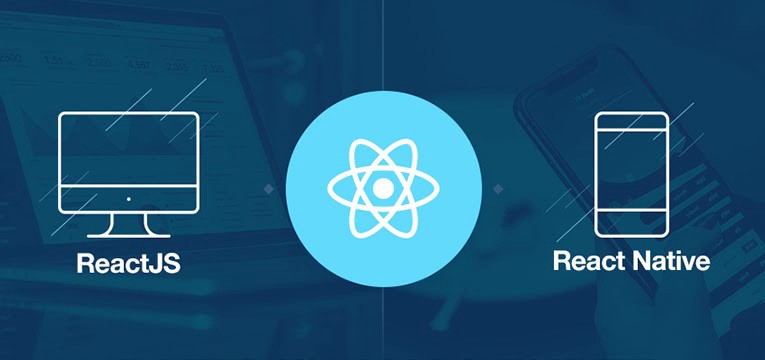React Native vs ReactJS: Facebook created React.js to fulfill its requirement for a dynamic and efficient User Interface (UI). In 2011, Jordan Walke and his Facebook team introduced React JS, a JavaScript library that combined the swiftness of JavaScript with a novel page rendering approach, resulting in a highly responsive and dynamic user experience. React.js gained widespread popularity after its open-source release in 2013, and in 2015, Facebook launched React Native.
Here is an outline highlighting the business benefits of utilizing React Native vs ReactJS, providing insights into their strengths and points of differentiation.
What is React Native?
React Native is a JavaScript framework that operates under an open-source model and is utilized for crafting mobile applications compatible with iOS, Android, and Windows platforms. It leverages JavaScript exclusively to construct cross-platform mobile apps. While React Native shares similarities with React, it distinguishes itself by employing native components instead of web components as the fundamental building blocks. Its primary focus is on mobile platforms rather than web browsers.
The genesis of React Native dates back to 2013 when Facebook initiated its development for an internal project Hackathon. In March 2015, Facebook made a significant announcement, declaring React Native as open-source and available for public access on GitHub. Initially designed for iOS applications, React Native has expanded its support to include the Android operating system in more recent times.
Features of React Native
Here are some key features of React Native:
Cross-platform functionality
React Native allows you to develop apps that work on multiple platforms without the need to change the code. This saves developers a significant amount of time.
Easy to learn and build on
React Native is designed to be user-friendly, making it easy for front-end developers with JavaScript knowledge to start building apps. It provides a familiar development environment.
Ready-to-use libraries and reusable components
React Native comes with a wide range of pre-built libraries and reusable components, which can significantly reduce coding time. Developers can leverage these resources to speed up the development process.
Seamless integration
React Native can be seamlessly integrated with existing mobile applications. This means you can incorporate React Native into your current project without starting from scratch.
Flexible architecture
React Native’s flexible architecture enables developers to complete development tasks more efficiently and easily. It provides a solid foundation for building complex and feature-rich applications.
iOS compatibility
React Native offers seamless integration with iOS coding, allowing developers to leverage their existing iOS knowledge. It is also compatible with JavaScript, making it a versatile choice for developers.
Interactive and customizable UI
React Native allows developers to create highly interactive and customizable user interfaces. It provides a wide range of tools and features to enhance the visual appeal and user experience of the app.
Real-time code updates
React Native offers a “hot reloading” feature, which allows developers to see the changes they make to the code in real time during the development process. This helps streamline the debugging and testing phases.
Benefits of Building with React Native
When comparing React Native vs ReactJS, React Native offers several advantages that can benefit your business:
- Ease of learning and supportive community: React Native is designed to be beginner-friendly, making it easy for developers to learn and start building mobile applications. Additionally, it has a large and supportive community that provides resources and assistance to developers, which can be valuable when encountering challenges.
- JavaScript-based development: React Native allows you to leverage your existing JavaScript knowledge to develop native mobile applications. This means you can utilize the same programming language and skills to build both web and mobile applications, reducing the learning curve and increasing development efficiency.
- Reusable code: React Native enables code reusability, which can save you significant time and money during the development process. You can reuse components and modules across different platforms, minimizing the need for rewriting code from scratch for each platform.
- Continuous improvements and updates: React Native is constantly evolving and receiving updates from the open-source community. This ensures that you have access to the latest features, enhancements, and bug fixes, keeping your mobile applications up to date and in line with industry standards.
Having understood the strengths of both React Native and ReactJS, let’s now delve into the differences between React and React Native.
What is ReactJS?
ReactJS is a JavaScript library that is open-source and widely used for constructing the user interface of web applications. Its primary focus is on the view layer of an application, allowing developers to create intricate user interfaces by assembling small, self-contained blocks of code known as “components.” ReactJS consists of two main elements: components, which encompass HTML code and define the desired visual elements of the user interface, and an HTML document where these components are rendered.
The library was created by Jordan Walke, a software engineer at Facebook. Initially developed and maintained by Facebook, ReactJS found its way into various Facebook products such as WhatsApp and Instagram. While initially intended for the newsfeed section of Facebook, ReactJS was made available to the public in May 2013.
Features of ReactJS
Here are some outstanding features of React JS:
Dynamic component updates
React excels at efficiently updating and rendering components based on changes in data. It provides a declarative view, making code easier to read and debug.
Efficient DOM handling
React’s virtual Document Object Model (DOM) implementation optimizes performance by minimizing direct manipulation of the actual DOM. This results in faster rendering and improved overall performance.
Minimal code for dynamic applications
React allows you to create highly dynamic applications with a user-friendly interface by writing minimal code. It simplifies the process of creating interactive and responsive UIs.
JavaScript simplicity
React’s use of JavaScript syntax makes it straightforward to learn and build upon. Developers familiar with JavaScript can quickly adapt to React and leverage their existing skills.
One-way data binding
React follows a one-way data flow, which helps reduce errors and makes the code more stable and maintainable. You can update specific components without the need to modify the entire component hierarchy.
HTML and library access
React provides access to HTML while also offering full access to libraries, allowing developers to leverage existing tools and frameworks within their React applications.
Component-based architecture
React allows you to break down your application into multiple components without affecting the underlying DOM structure. This modular approach enhances code reusability and maintainability.
Constant evolution and updates
React is a vibrant open-source ecosystem that is continuously evolving. Developers worldwide contribute to its growth, ensuring a steady stream of updates, new features, and bug fixes.
Real-time changes and error reduction
React’s development environment enables developers to view real-time changes as they make them, minimizing the potential for errors and simplifying the debugging process.
Search engine optimization (SEO) capabilities
React facilitates efficient indexing by search engines, helping improve the discoverability and visibility of React-based websites.
Fast, efficient, and high-performing websites: React’s performance optimizations, virtual DOM handling, and efficient rendering contribute to building websites that are fast, efficient, and high-performing.
Benefits of Building with ReactJS
There are several benefits to building with ReactJS:
- Component-based architecture: Break down your user interface into reusable components, promoting code reusability and scalability.
- Virtual DOM: Efficiently update and render components with the virtual DOM, leading to faster rendering and improved application speed.
- Declarative syntax: Describe how your UI should look based on the application state, improving code understanding and productivity.
- One-way data flow: Maintain a clear and predictable data flow from parent to child components for easier state management.
- React Native compatibility: Leverage your ReactJS knowledge to build native mobile apps, saving time and effort in development.
- Large community: Access abundant resources, tutorials, and libraries for support and staying up to date.
- Performance optimizations: Benefit from virtual DOM diffing and rendering algorithms for faster and more responsive applications.
- SEO-friendly: Support server-side rendering for improved SEO and better content discoverability.
- Tooling ecosystem: Enjoy a wide range of development tools, extensions, and frameworks to enhance productivity and functionality.
Overall, ReactJS offers numerous benefits that make it an excellent choice for building modern, scalable, and performant web applications.
The Drawbacks: React Native vs ReactJS
React JS:
- JSX
React JS utilizes JSX (JavaScript XML), which allows developers to write HTML code within React. However, some developers find JSX documentation difficult to comprehend, making it less favorable, particularly for beginners.
- Constant Library Updates
One of the concerns with React JS is the frequent changes in the React library, which can hinder the speed of app development. However, recent React improvements have primarily focused on enhancing libraries and introducing other updates, resulting in more stable code.
- Third-party Integration
While React provides numerous third-party modules and plugins, it has limited native modules. Integrating third-party solutions may involve complex combinations of HTML, CSS, and JSX.
React Native:
- Shortage of Custom Modules
In applications with extensive features, React Native may experience slower development due to a lack of native modules and reliance on third-party libraries. Additionally, creating a custom module would require separate codebases for React Native, iOS, and Android platforms.
- Frequent Updates
React Native is continuously evolving, with regular updates introducing new ported native components, performance enhancements, and improved custom components. While updates are generally beneficial, developers must take into account the potential implications when compared to other highly mature cross-platform app development frameworks.
- Load Time
React Native developers often face challenges with application load time, primarily because of the JavaScript thread. Deploying the application can be time-consuming due to the inherent nature of the thread.
Difference between React Native vs ReactJS
React Native and ReactJS are both popular frameworks developed by Facebook, but they serve different purposes and target different platforms. Here’s a breakdown of the differences between React Native vs ReactJS in various categories:
1. Platform:
-
- ReactJS: It is a JavaScript library for building user interfaces primarily for web applications. It renders components on the web using the DOM (Document Object Model) and is compatible with web browsers.
- React Native: It is a framework for building native mobile applications using JavaScript. It renders components using native UI components specific to the target platform, such as iOS or Android.
2. User Interface:
-
- ReactJS: It provides a web-based user interface using HTML, CSS, and JavaScript. The UI is rendered within the web browser and can be accessed through URLs.
- React Native: It provides a native user interface for mobile applications. The UI components are rendered using native views and widgets specific to the platform, resulting in a more native look and feel.
3. Code Reusability
-
- ReactJS: The code written in ReactJS is not directly reusable in React Native. However, ReactJS code can be reused in React Native indirectly by sharing business logic and some utility functions.
- React Native: It offers a higher level of code reusability. With React Native, you can reuse a significant portion of the codebase between iOS and Android platforms, as the core business logic and components are written in JavaScript.
4. Performance
-
- ReactJS: It relies on the web browser’s rendering capabilities, which may introduce certain performance limitations. While ReactJS has optimizations such as virtual DOM diffing, it may not match the performance of a fully native application.
- React Native: It provides better performance compared to ReactJS for mobile applications. React Native leverages native UI components, allowing for smoother animations, faster rendering, and overall better performance on mobile devices.
5. Development Workflow
-
- ReactJS: The development workflow for ReactJS involves developing and testing in a web browser. Developers can take advantage of various web development tools and libraries to build and debug ReactJS applications.
- React Native: The development workflow for React Native involves using an emulator or a physical device for testing. React Native provides tools and libraries specifically designed for mobile app development, such as hot reloading and debugging tools.
6. Access to Device Features
-
- ReactJS: It primarily focuses on web development and does not provide direct access to native device features, such as camera, GPS, or push notifications. However, it can integrate with JavaScript-based libraries or plugins to access certain device features indirectly.
- React Native: It offers direct access to native device features and APIs, allowing developers to utilize functionalities such as cameras, GPS, sensors, and push notifications without relying on additional plugins or libraries.
7. Community and Ecosystem
-
- ReactJS: It has a vast and mature community with numerous resources, libraries, and tools available. The ReactJS ecosystem provides solutions for various web development needs, including state management, routing, and UI component libraries.
- React Native: Although not as extensive as ReactJS, React Native has a growing and active community. It offers libraries and tools specifically tailored for mobile app development, including navigation, state management, and UI component libraries.
In summary, ReactJS is ideal for building web applications, while React Native is suitable for developing native mobile applications. ReactJS leverages the web browser’s capabilities, while React Native provides a more native user experience on mobile platforms. While there are similarities in syntax and component-based architecture, the frameworks differ in platform compatibility, code reusability, performance, and access to device features.
Choosing the Right Framework
When deciding between React Native and ReactJS, it’s essential to consider the specific requirements of your project. If you’re aiming to build a mobile application for both iOS and Android, with a focus on native-like performance and access to device-specific features, React Native is the ideal choice. On the other hand, if your goal is to develop a web application with a rich user interface and you don’t require native mobile capabilities, ReactJS is the more suitable option.
It’s worth mentioning that React Native and ReactJS are not mutually exclusive. They can be used together in a project, where ReactJS handles the web part and React Native caters to the mobile application. This approach allows for code sharing between platforms and a consistent user experience across devices.
Conclusion
React Native vs ReactJS are powerful frameworks that enable developers to create compelling user interfaces for mobile and web applications, respectively. While they share commonalities, their divergent focuses and target platforms set them apart. By considering factors such as platform compatibility, UI requirements, and project scope, you can make an informed decision and choose the framework
At ONEXT DIGITAL, we are providing React Native and ReactJS development for all your mobile and web application needs. Our team of skilled developers excels in leveraging these technologies to create powerful and seamless user experiences across multiple platforms. When it comes to React Native and ReactJS development, our team is well-equipped to deliver exceptional results. Contact us today to discuss your requirements and embark on a successful journey of building innovative and high-performing mobile and web applications with React Native and ReactJS.









